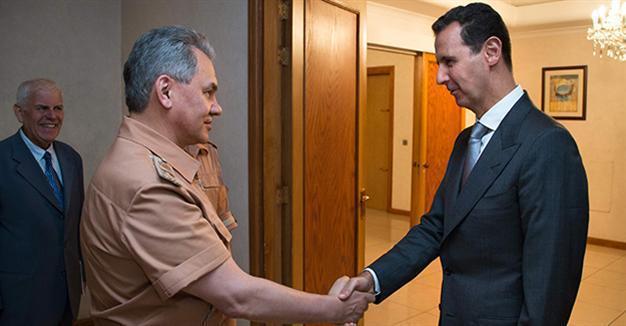Russian minister visits Assad, base in Syria
BEIRUT/AMMAN

AFP photo
U.S.-backed Syrian forces edged closer to an Islamic State of Iraq and the Levant (ISIL) stronghold on the border with Turkey on June 18 while the Russian defense minister visited Syrian President Bashar al Assad to discuss military operations.
The Russian state media did not disclose any details of the previously unannounced visit by Sergei Shoigu, who said he was sent to Damascus by Russian President Vladimir Putin.
The minister had joined June 9 his Iranian and Syrian counterparts in Tehran to discuss ways to enhance their cooperation in fighting Islamic State of Iraq and Syria (ISIL) and al-Qaeda.
The recent visit came only hours after the Syrian army and its Iranian-backed militias, which have been supported by Russian air power, lost several villages to Islamist rebels as they made significant advances in the countryside south of Aleppo.
The U.K.-based Syrian Observatory for Human Rights said the rebel capture of three villages from government control - Zeitan, Khalsa and Barna - had caused significant losses among government forces and their allies.
The villages lie in a strategic area near a main highway that links Aleppo with the capital Damascus.
Government forces captured the area at the end of last year in a major offensive, assisted by Iranian-backed militias and Russian jets.
State media said Russian Defence Minister Sergei Shoigu visited an airbase in the coastal Latakia province after his talks with Assad in Damascus.
On the border with Turkey, U.S.-backed Syrian forces fought to the western entrance of Manbij city for the first time since a major offensive to seize the last territory held by ISIL on the frontier, a source in the Syrian group said on June 18.
Meanwhile, the Russian military on June 19 that it rejected the Pentagon’s accusations that it had deliberately targeted U.S.-backed Syrian opposition forces, arguing the U.S. had failed to warn about their locations.
Russian Defense Ministry spokesman, Maj. Gen. Igor Konashenkov, said the area targeted in the strike was more than 300 kilometers away from locations earlier designated by the U.S. as controlled by legitimate opposition forces.
The Pentagon said it held a video conference on June 18 with the Russian military to discuss Russian air strikes on June 16 on the At-Tanf border garrison, which targeted Syrian opposition forces fighting ISIL.
“Russia’s continued strikes at At-Tanf, even after U.S. attempts to inform Russian forces through proper channels of ongoing coalition air support to the counter-ISIL forces, created safety concerns for U.S. and coalition forces,” it said in a statement.
Konashenkov retorted that the Russian military had warned the U.S. in advance about the planned strike, but the Pentagon had failed to provide coordinates of legitimate opposition forces, “making it impossible to take measures to adjust the Russian air force action.”
